Contemporary Management Theory: Culture and Performance Impact
VerifiedAdded on 2023/06/14
|8
|2395
|190
Essay
AI Summary
This essay examines the significance of organizational culture within a business context, emphasizing its profound impact on performance management. It delves into various models of organizational culture, such as clan, holacracy, and meritocracy, and their respective effects on employee engagement and innovation. Furthermore, the essay elucidates the crucial roles of leadership and management in fostering a positive organizational culture, highlighting how effective leadership can inspire and motivate employees, leading to increased productivity and profitability. The analysis underscores that a favorable organizational culture is instrumental in enhancing employee retention, creating a strong corporate identity, and ultimately achieving organizational objectives and goals. Desklib provides access to this essay and many other resources for students.
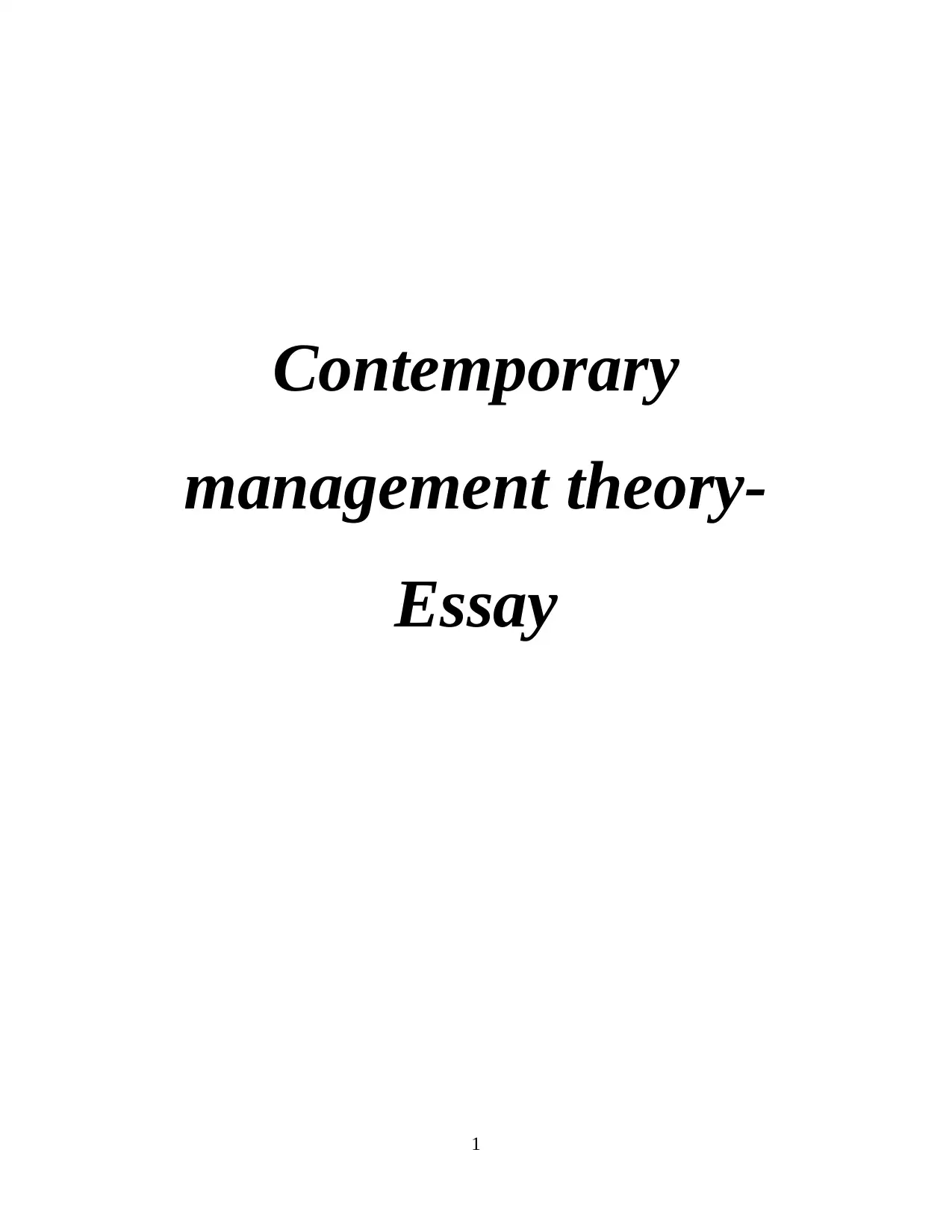
Contemporary
management theory-
Essay
1
management theory-
Essay
1
Paraphrase This Document
Need a fresh take? Get an instant paraphrase of this document with our AI Paraphraser
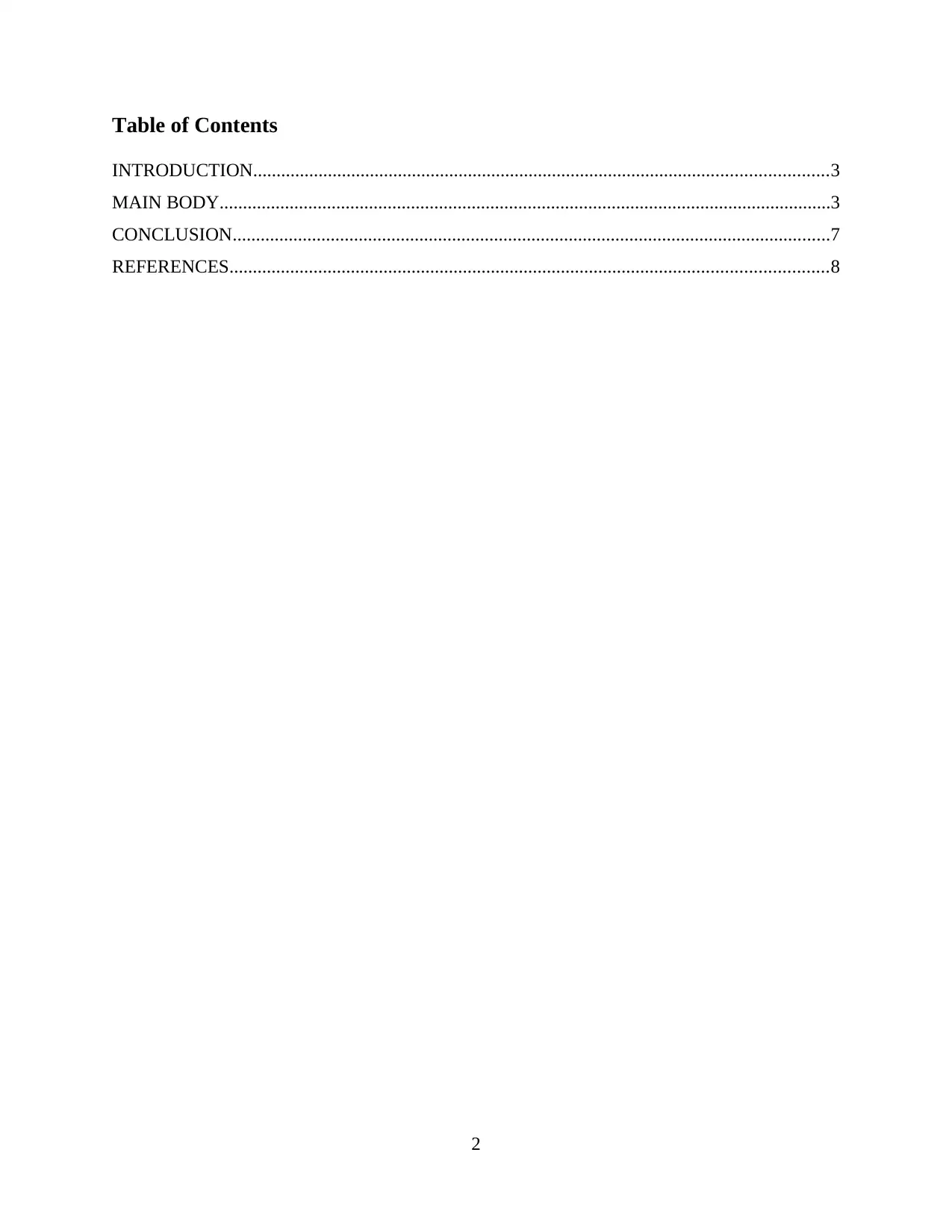
Table of Contents
INTRODUCTION...........................................................................................................................3
MAIN BODY...................................................................................................................................3
CONCLUSION................................................................................................................................7
REFERENCES................................................................................................................................8
2
INTRODUCTION...........................................................................................................................3
MAIN BODY...................................................................................................................................3
CONCLUSION................................................................................................................................7
REFERENCES................................................................................................................................8
2
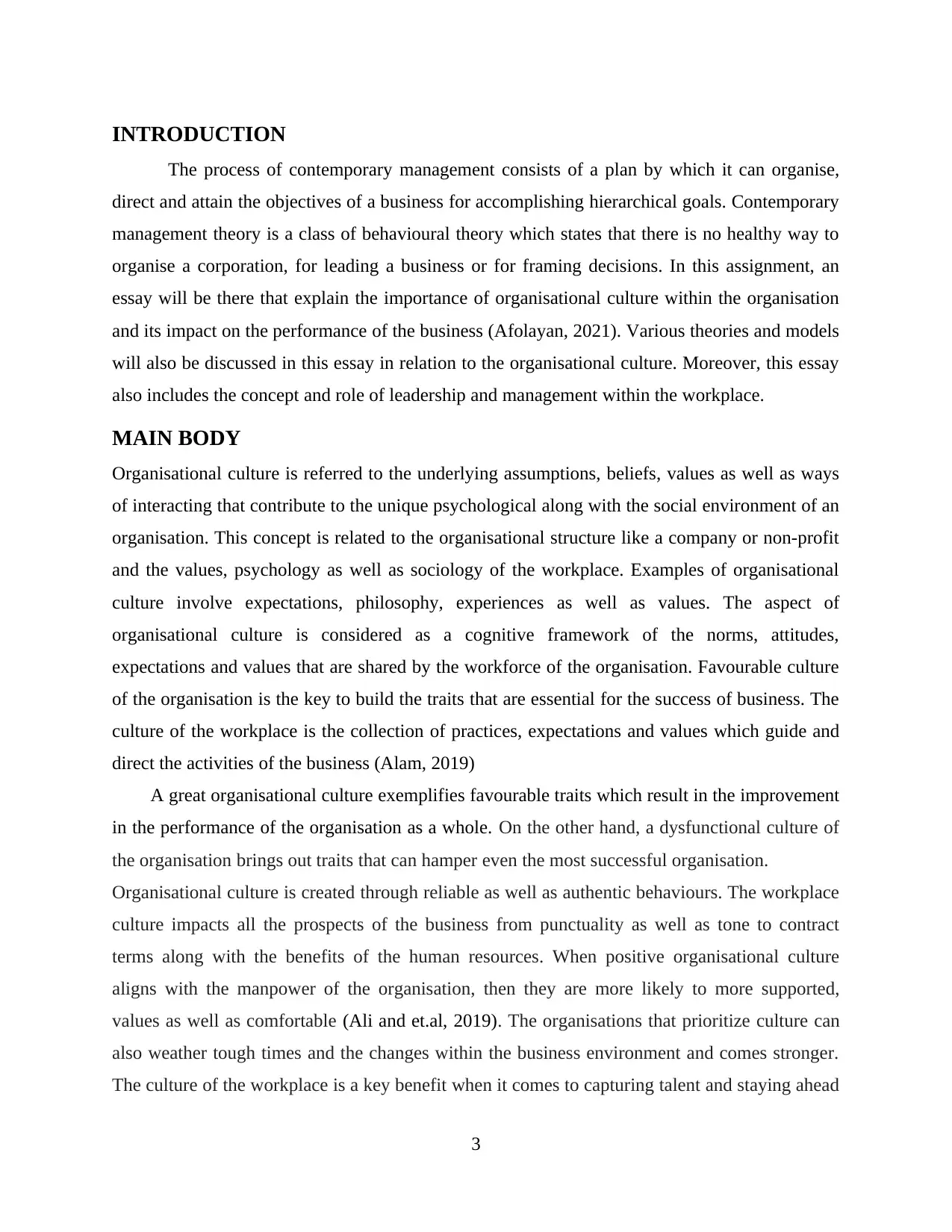
INTRODUCTION
The process of contemporary management consists of a plan by which it can organise,
direct and attain the objectives of a business for accomplishing hierarchical goals. Contemporary
management theory is a class of behavioural theory which states that there is no healthy way to
organise a corporation, for leading a business or for framing decisions. In this assignment, an
essay will be there that explain the importance of organisational culture within the organisation
and its impact on the performance of the business (Afolayan, 2021). Various theories and models
will also be discussed in this essay in relation to the organisational culture. Moreover, this essay
also includes the concept and role of leadership and management within the workplace.
MAIN BODY
Organisational culture is referred to the underlying assumptions, beliefs, values as well as ways
of interacting that contribute to the unique psychological along with the social environment of an
organisation. This concept is related to the organisational structure like a company or non-profit
and the values, psychology as well as sociology of the workplace. Examples of organisational
culture involve expectations, philosophy, experiences as well as values. The aspect of
organisational culture is considered as a cognitive framework of the norms, attitudes,
expectations and values that are shared by the workforce of the organisation. Favourable culture
of the organisation is the key to build the traits that are essential for the success of business. The
culture of the workplace is the collection of practices, expectations and values which guide and
direct the activities of the business (Alam, 2019)
A great organisational culture exemplifies favourable traits which result in the improvement
in the performance of the organisation as a whole. On the other hand, a dysfunctional culture of
the organisation brings out traits that can hamper even the most successful organisation.
Organisational culture is created through reliable as well as authentic behaviours. The workplace
culture impacts all the prospects of the business from punctuality as well as tone to contract
terms along with the benefits of the human resources. When positive organisational culture
aligns with the manpower of the organisation, then they are more likely to more supported,
values as well as comfortable (Ali and et.al, 2019). The organisations that prioritize culture can
also weather tough times and the changes within the business environment and comes stronger.
The culture of the workplace is a key benefit when it comes to capturing talent and staying ahead
3
The process of contemporary management consists of a plan by which it can organise,
direct and attain the objectives of a business for accomplishing hierarchical goals. Contemporary
management theory is a class of behavioural theory which states that there is no healthy way to
organise a corporation, for leading a business or for framing decisions. In this assignment, an
essay will be there that explain the importance of organisational culture within the organisation
and its impact on the performance of the business (Afolayan, 2021). Various theories and models
will also be discussed in this essay in relation to the organisational culture. Moreover, this essay
also includes the concept and role of leadership and management within the workplace.
MAIN BODY
Organisational culture is referred to the underlying assumptions, beliefs, values as well as ways
of interacting that contribute to the unique psychological along with the social environment of an
organisation. This concept is related to the organisational structure like a company or non-profit
and the values, psychology as well as sociology of the workplace. Examples of organisational
culture involve expectations, philosophy, experiences as well as values. The aspect of
organisational culture is considered as a cognitive framework of the norms, attitudes,
expectations and values that are shared by the workforce of the organisation. Favourable culture
of the organisation is the key to build the traits that are essential for the success of business. The
culture of the workplace is the collection of practices, expectations and values which guide and
direct the activities of the business (Alam, 2019)
A great organisational culture exemplifies favourable traits which result in the improvement
in the performance of the organisation as a whole. On the other hand, a dysfunctional culture of
the organisation brings out traits that can hamper even the most successful organisation.
Organisational culture is created through reliable as well as authentic behaviours. The workplace
culture impacts all the prospects of the business from punctuality as well as tone to contract
terms along with the benefits of the human resources. When positive organisational culture
aligns with the manpower of the organisation, then they are more likely to more supported,
values as well as comfortable (Ali and et.al, 2019). The organisations that prioritize culture can
also weather tough times and the changes within the business environment and comes stronger.
The culture of the workplace is a key benefit when it comes to capturing talent and staying ahead
3
⊘ This is a preview!⊘
Do you want full access?
Subscribe today to unlock all pages.

Trusted by 1+ million students worldwide
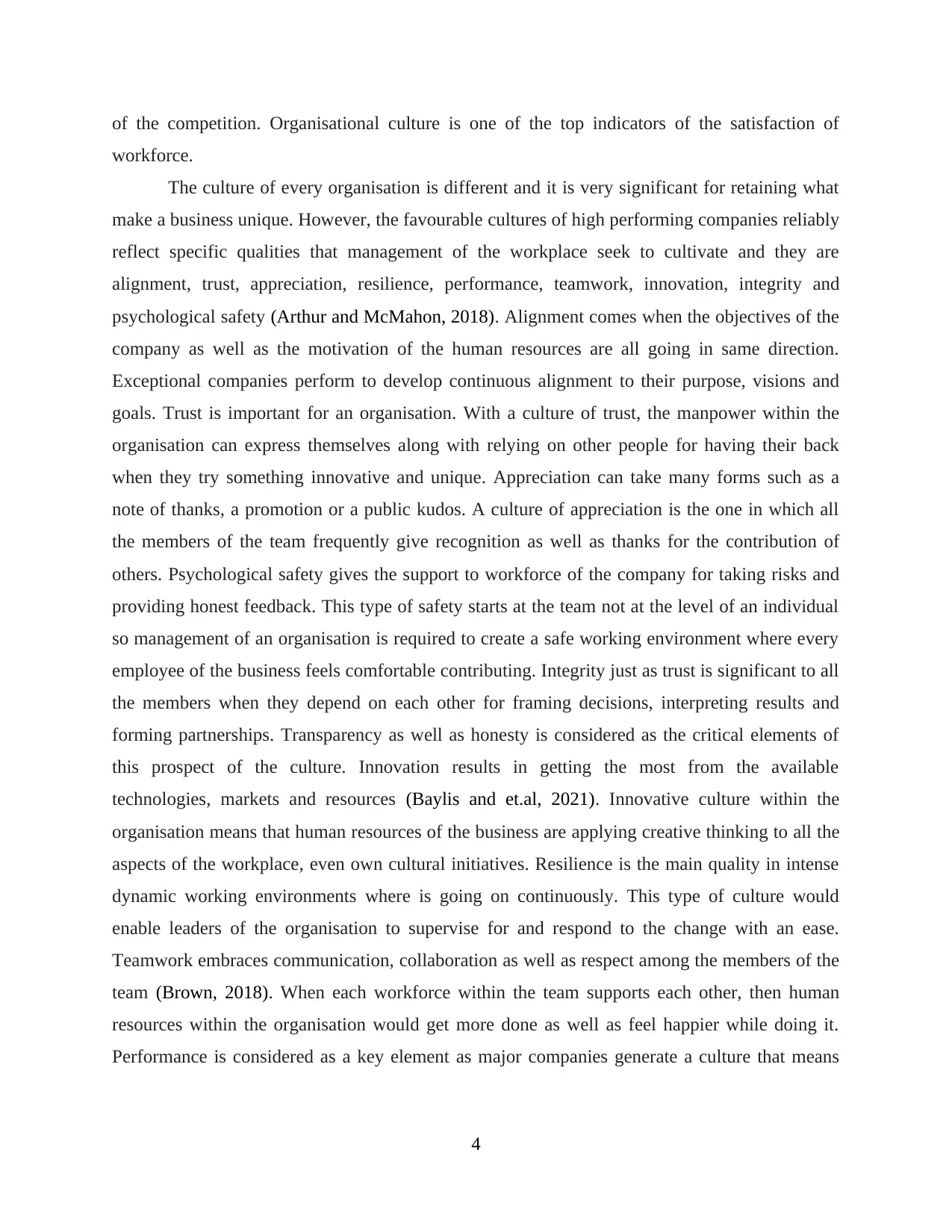
of the competition. Organisational culture is one of the top indicators of the satisfaction of
workforce.
The culture of every organisation is different and it is very significant for retaining what
make a business unique. However, the favourable cultures of high performing companies reliably
reflect specific qualities that management of the workplace seek to cultivate and they are
alignment, trust, appreciation, resilience, performance, teamwork, innovation, integrity and
psychological safety (Arthur and McMahon, 2018). Alignment comes when the objectives of the
company as well as the motivation of the human resources are all going in same direction.
Exceptional companies perform to develop continuous alignment to their purpose, visions and
goals. Trust is important for an organisation. With a culture of trust, the manpower within the
organisation can express themselves along with relying on other people for having their back
when they try something innovative and unique. Appreciation can take many forms such as a
note of thanks, a promotion or a public kudos. A culture of appreciation is the one in which all
the members of the team frequently give recognition as well as thanks for the contribution of
others. Psychological safety gives the support to workforce of the company for taking risks and
providing honest feedback. This type of safety starts at the team not at the level of an individual
so management of an organisation is required to create a safe working environment where every
employee of the business feels comfortable contributing. Integrity just as trust is significant to all
the members when they depend on each other for framing decisions, interpreting results and
forming partnerships. Transparency as well as honesty is considered as the critical elements of
this prospect of the culture. Innovation results in getting the most from the available
technologies, markets and resources (Baylis and et.al, 2021). Innovative culture within the
organisation means that human resources of the business are applying creative thinking to all the
aspects of the workplace, even own cultural initiatives. Resilience is the main quality in intense
dynamic working environments where is going on continuously. This type of culture would
enable leaders of the organisation to supervise for and respond to the change with an ease.
Teamwork embraces communication, collaboration as well as respect among the members of the
team (Brown, 2018). When each workforce within the team supports each other, then human
resources within the organisation would get more done as well as feel happier while doing it.
Performance is considered as a key element as major companies generate a culture that means
4
workforce.
The culture of every organisation is different and it is very significant for retaining what
make a business unique. However, the favourable cultures of high performing companies reliably
reflect specific qualities that management of the workplace seek to cultivate and they are
alignment, trust, appreciation, resilience, performance, teamwork, innovation, integrity and
psychological safety (Arthur and McMahon, 2018). Alignment comes when the objectives of the
company as well as the motivation of the human resources are all going in same direction.
Exceptional companies perform to develop continuous alignment to their purpose, visions and
goals. Trust is important for an organisation. With a culture of trust, the manpower within the
organisation can express themselves along with relying on other people for having their back
when they try something innovative and unique. Appreciation can take many forms such as a
note of thanks, a promotion or a public kudos. A culture of appreciation is the one in which all
the members of the team frequently give recognition as well as thanks for the contribution of
others. Psychological safety gives the support to workforce of the company for taking risks and
providing honest feedback. This type of safety starts at the team not at the level of an individual
so management of an organisation is required to create a safe working environment where every
employee of the business feels comfortable contributing. Integrity just as trust is significant to all
the members when they depend on each other for framing decisions, interpreting results and
forming partnerships. Transparency as well as honesty is considered as the critical elements of
this prospect of the culture. Innovation results in getting the most from the available
technologies, markets and resources (Baylis and et.al, 2021). Innovative culture within the
organisation means that human resources of the business are applying creative thinking to all the
aspects of the workplace, even own cultural initiatives. Resilience is the main quality in intense
dynamic working environments where is going on continuously. This type of culture would
enable leaders of the organisation to supervise for and respond to the change with an ease.
Teamwork embraces communication, collaboration as well as respect among the members of the
team (Brown, 2018). When each workforce within the team supports each other, then human
resources within the organisation would get more done as well as feel happier while doing it.
Performance is considered as a key element as major companies generate a culture that means
4
Paraphrase This Document
Need a fresh take? Get an instant paraphrase of this document with our AI Paraphraser
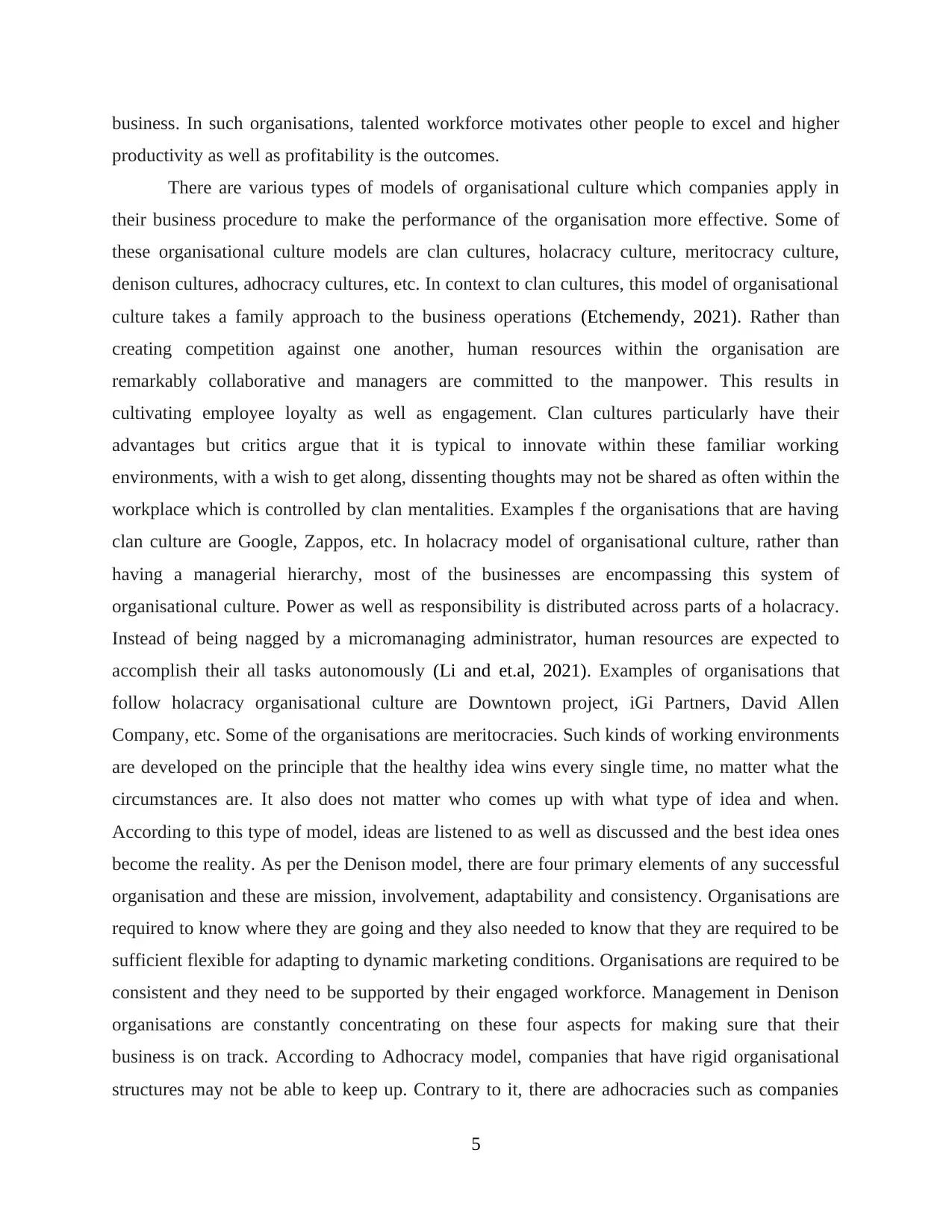
business. In such organisations, talented workforce motivates other people to excel and higher
productivity as well as profitability is the outcomes.
There are various types of models of organisational culture which companies apply in
their business procedure to make the performance of the organisation more effective. Some of
these organisational culture models are clan cultures, holacracy culture, meritocracy culture,
denison cultures, adhocracy cultures, etc. In context to clan cultures, this model of organisational
culture takes a family approach to the business operations (Etchemendy, 2021). Rather than
creating competition against one another, human resources within the organisation are
remarkably collaborative and managers are committed to the manpower. This results in
cultivating employee loyalty as well as engagement. Clan cultures particularly have their
advantages but critics argue that it is typical to innovate within these familiar working
environments, with a wish to get along, dissenting thoughts may not be shared as often within the
workplace which is controlled by clan mentalities. Examples f the organisations that are having
clan culture are Google, Zappos, etc. In holacracy model of organisational culture, rather than
having a managerial hierarchy, most of the businesses are encompassing this system of
organisational culture. Power as well as responsibility is distributed across parts of a holacracy.
Instead of being nagged by a micromanaging administrator, human resources are expected to
accomplish their all tasks autonomously (Li and et.al, 2021). Examples of organisations that
follow holacracy organisational culture are Downtown project, iGi Partners, David Allen
Company, etc. Some of the organisations are meritocracies. Such kinds of working environments
are developed on the principle that the healthy idea wins every single time, no matter what the
circumstances are. It also does not matter who comes up with what type of idea and when.
According to this type of model, ideas are listened to as well as discussed and the best idea ones
become the reality. As per the Denison model, there are four primary elements of any successful
organisation and these are mission, involvement, adaptability and consistency. Organisations are
required to know where they are going and they also needed to know that they are required to be
sufficient flexible for adapting to dynamic marketing conditions. Organisations are required to be
consistent and they need to be supported by their engaged workforce. Management in Denison
organisations are constantly concentrating on these four aspects for making sure that their
business is on track. According to Adhocracy model, companies that have rigid organisational
structures may not be able to keep up. Contrary to it, there are adhocracies such as companies
5
productivity as well as profitability is the outcomes.
There are various types of models of organisational culture which companies apply in
their business procedure to make the performance of the organisation more effective. Some of
these organisational culture models are clan cultures, holacracy culture, meritocracy culture,
denison cultures, adhocracy cultures, etc. In context to clan cultures, this model of organisational
culture takes a family approach to the business operations (Etchemendy, 2021). Rather than
creating competition against one another, human resources within the organisation are
remarkably collaborative and managers are committed to the manpower. This results in
cultivating employee loyalty as well as engagement. Clan cultures particularly have their
advantages but critics argue that it is typical to innovate within these familiar working
environments, with a wish to get along, dissenting thoughts may not be shared as often within the
workplace which is controlled by clan mentalities. Examples f the organisations that are having
clan culture are Google, Zappos, etc. In holacracy model of organisational culture, rather than
having a managerial hierarchy, most of the businesses are encompassing this system of
organisational culture. Power as well as responsibility is distributed across parts of a holacracy.
Instead of being nagged by a micromanaging administrator, human resources are expected to
accomplish their all tasks autonomously (Li and et.al, 2021). Examples of organisations that
follow holacracy organisational culture are Downtown project, iGi Partners, David Allen
Company, etc. Some of the organisations are meritocracies. Such kinds of working environments
are developed on the principle that the healthy idea wins every single time, no matter what the
circumstances are. It also does not matter who comes up with what type of idea and when.
According to this type of model, ideas are listened to as well as discussed and the best idea ones
become the reality. As per the Denison model, there are four primary elements of any successful
organisation and these are mission, involvement, adaptability and consistency. Organisations are
required to know where they are going and they also needed to know that they are required to be
sufficient flexible for adapting to dynamic marketing conditions. Organisations are required to be
consistent and they need to be supported by their engaged workforce. Management in Denison
organisations are constantly concentrating on these four aspects for making sure that their
business is on track. According to Adhocracy model, companies that have rigid organisational
structures may not be able to keep up. Contrary to it, there are adhocracies such as companies
5
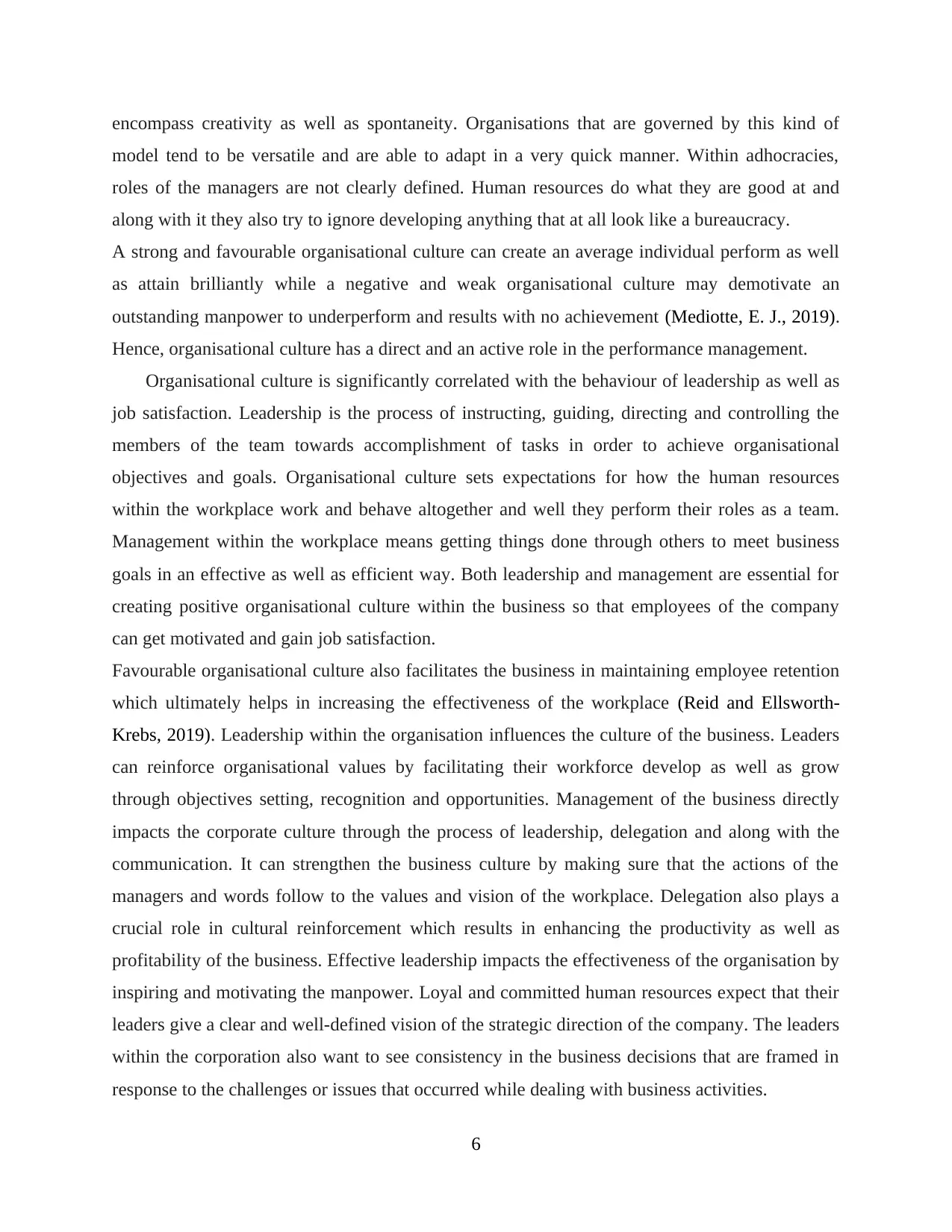
encompass creativity as well as spontaneity. Organisations that are governed by this kind of
model tend to be versatile and are able to adapt in a very quick manner. Within adhocracies,
roles of the managers are not clearly defined. Human resources do what they are good at and
along with it they also try to ignore developing anything that at all look like a bureaucracy.
A strong and favourable organisational culture can create an average individual perform as well
as attain brilliantly while a negative and weak organisational culture may demotivate an
outstanding manpower to underperform and results with no achievement (Mediotte, E. J., 2019).
Hence, organisational culture has a direct and an active role in the performance management.
Organisational culture is significantly correlated with the behaviour of leadership as well as
job satisfaction. Leadership is the process of instructing, guiding, directing and controlling the
members of the team towards accomplishment of tasks in order to achieve organisational
objectives and goals. Organisational culture sets expectations for how the human resources
within the workplace work and behave altogether and well they perform their roles as a team.
Management within the workplace means getting things done through others to meet business
goals in an effective as well as efficient way. Both leadership and management are essential for
creating positive organisational culture within the business so that employees of the company
can get motivated and gain job satisfaction.
Favourable organisational culture also facilitates the business in maintaining employee retention
which ultimately helps in increasing the effectiveness of the workplace (Reid and Ellsworth-
Krebs, 2019). Leadership within the organisation influences the culture of the business. Leaders
can reinforce organisational values by facilitating their workforce develop as well as grow
through objectives setting, recognition and opportunities. Management of the business directly
impacts the corporate culture through the process of leadership, delegation and along with the
communication. It can strengthen the business culture by making sure that the actions of the
managers and words follow to the values and vision of the workplace. Delegation also plays a
crucial role in cultural reinforcement which results in enhancing the productivity as well as
profitability of the business. Effective leadership impacts the effectiveness of the organisation by
inspiring and motivating the manpower. Loyal and committed human resources expect that their
leaders give a clear and well-defined vision of the strategic direction of the company. The leaders
within the corporation also want to see consistency in the business decisions that are framed in
response to the challenges or issues that occurred while dealing with business activities.
6
model tend to be versatile and are able to adapt in a very quick manner. Within adhocracies,
roles of the managers are not clearly defined. Human resources do what they are good at and
along with it they also try to ignore developing anything that at all look like a bureaucracy.
A strong and favourable organisational culture can create an average individual perform as well
as attain brilliantly while a negative and weak organisational culture may demotivate an
outstanding manpower to underperform and results with no achievement (Mediotte, E. J., 2019).
Hence, organisational culture has a direct and an active role in the performance management.
Organisational culture is significantly correlated with the behaviour of leadership as well as
job satisfaction. Leadership is the process of instructing, guiding, directing and controlling the
members of the team towards accomplishment of tasks in order to achieve organisational
objectives and goals. Organisational culture sets expectations for how the human resources
within the workplace work and behave altogether and well they perform their roles as a team.
Management within the workplace means getting things done through others to meet business
goals in an effective as well as efficient way. Both leadership and management are essential for
creating positive organisational culture within the business so that employees of the company
can get motivated and gain job satisfaction.
Favourable organisational culture also facilitates the business in maintaining employee retention
which ultimately helps in increasing the effectiveness of the workplace (Reid and Ellsworth-
Krebs, 2019). Leadership within the organisation influences the culture of the business. Leaders
can reinforce organisational values by facilitating their workforce develop as well as grow
through objectives setting, recognition and opportunities. Management of the business directly
impacts the corporate culture through the process of leadership, delegation and along with the
communication. It can strengthen the business culture by making sure that the actions of the
managers and words follow to the values and vision of the workplace. Delegation also plays a
crucial role in cultural reinforcement which results in enhancing the productivity as well as
profitability of the business. Effective leadership impacts the effectiveness of the organisation by
inspiring and motivating the manpower. Loyal and committed human resources expect that their
leaders give a clear and well-defined vision of the strategic direction of the company. The leaders
within the corporation also want to see consistency in the business decisions that are framed in
response to the challenges or issues that occurred while dealing with business activities.
6
⊘ This is a preview!⊘
Do you want full access?
Subscribe today to unlock all pages.

Trusted by 1+ million students worldwide
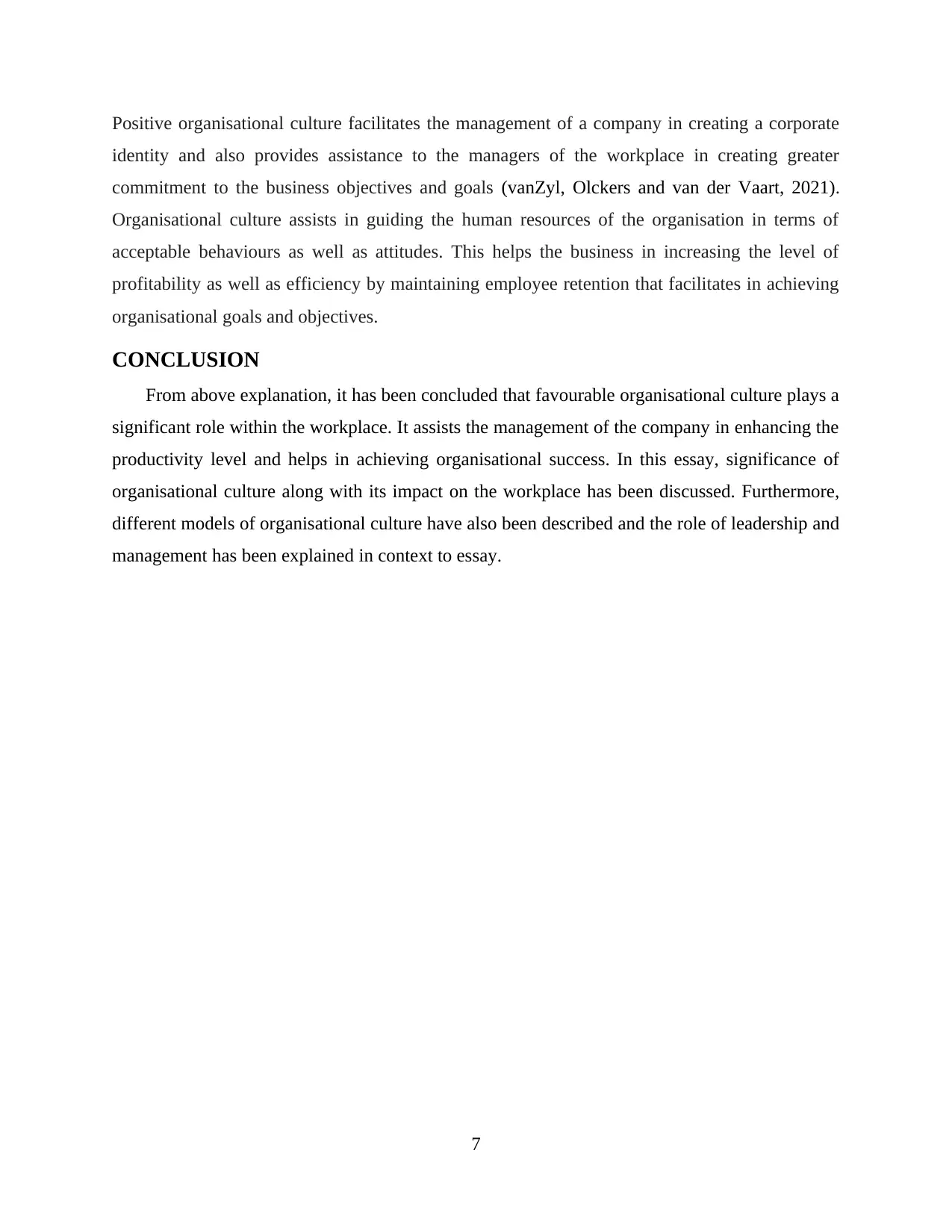
Positive organisational culture facilitates the management of a company in creating a corporate
identity and also provides assistance to the managers of the workplace in creating greater
commitment to the business objectives and goals (vanZyl, Olckers and van der Vaart, 2021).
Organisational culture assists in guiding the human resources of the organisation in terms of
acceptable behaviours as well as attitudes. This helps the business in increasing the level of
profitability as well as efficiency by maintaining employee retention that facilitates in achieving
organisational goals and objectives.
CONCLUSION
From above explanation, it has been concluded that favourable organisational culture plays a
significant role within the workplace. It assists the management of the company in enhancing the
productivity level and helps in achieving organisational success. In this essay, significance of
organisational culture along with its impact on the workplace has been discussed. Furthermore,
different models of organisational culture have also been described and the role of leadership and
management has been explained in context to essay.
7
identity and also provides assistance to the managers of the workplace in creating greater
commitment to the business objectives and goals (vanZyl, Olckers and van der Vaart, 2021).
Organisational culture assists in guiding the human resources of the organisation in terms of
acceptable behaviours as well as attitudes. This helps the business in increasing the level of
profitability as well as efficiency by maintaining employee retention that facilitates in achieving
organisational goals and objectives.
CONCLUSION
From above explanation, it has been concluded that favourable organisational culture plays a
significant role within the workplace. It assists the management of the company in enhancing the
productivity level and helps in achieving organisational success. In this essay, significance of
organisational culture along with its impact on the workplace has been discussed. Furthermore,
different models of organisational culture have also been described and the role of leadership and
management has been explained in context to essay.
7
Paraphrase This Document
Need a fresh take? Get an instant paraphrase of this document with our AI Paraphraser
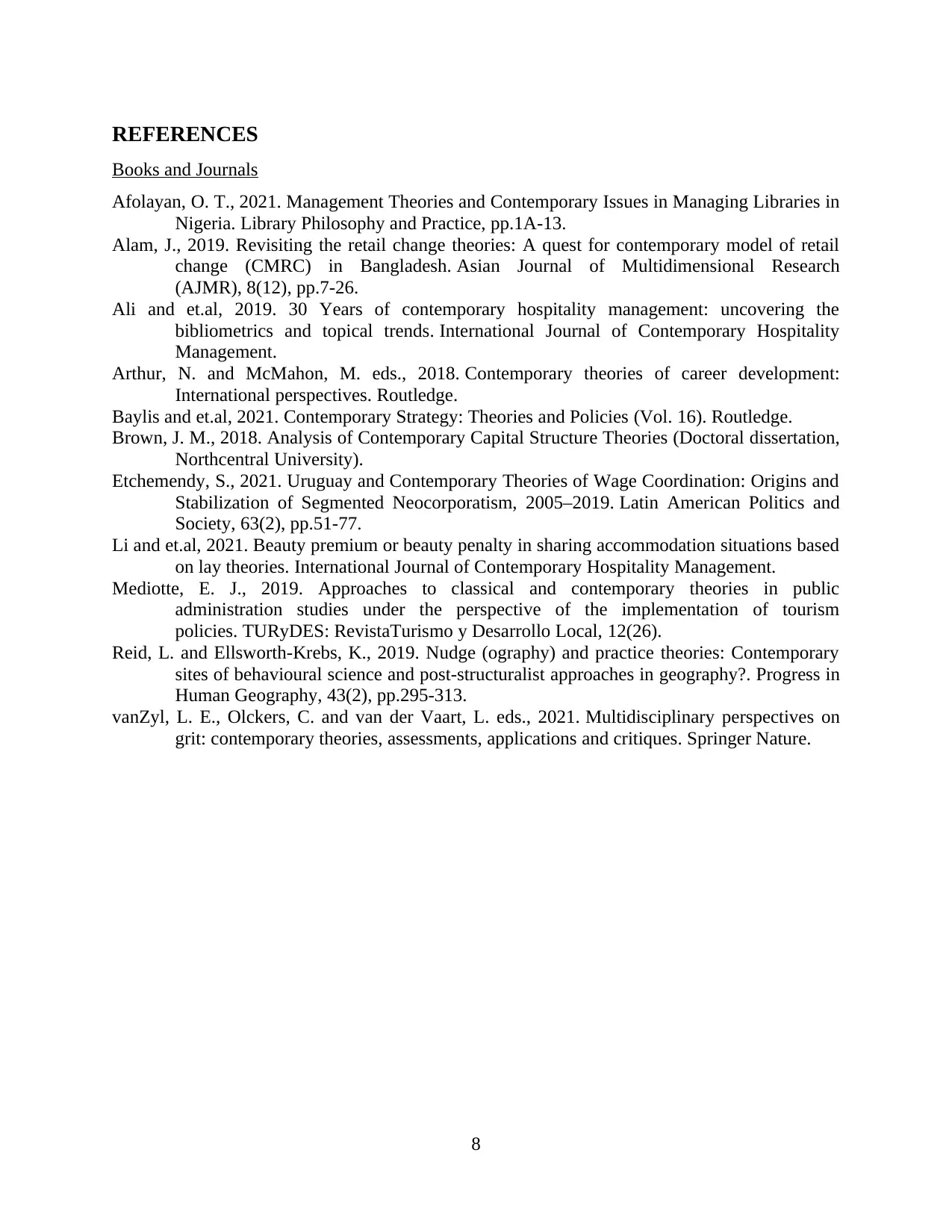
REFERENCES
Books and Journals
Afolayan, O. T., 2021. Management Theories and Contemporary Issues in Managing Libraries in
Nigeria. Library Philosophy and Practice, pp.1A-13.
Alam, J., 2019. Revisiting the retail change theories: A quest for contemporary model of retail
change (CMRC) in Bangladesh. Asian Journal of Multidimensional Research
(AJMR), 8(12), pp.7-26.
Ali and et.al, 2019. 30 Years of contemporary hospitality management: uncovering the
bibliometrics and topical trends. International Journal of Contemporary Hospitality
Management.
Arthur, N. and McMahon, M. eds., 2018. Contemporary theories of career development:
International perspectives. Routledge.
Baylis and et.al, 2021. Contemporary Strategy: Theories and Policies (Vol. 16). Routledge.
Brown, J. M., 2018. Analysis of Contemporary Capital Structure Theories (Doctoral dissertation,
Northcentral University).
Etchemendy, S., 2021. Uruguay and Contemporary Theories of Wage Coordination: Origins and
Stabilization of Segmented Neocorporatism, 2005–2019. Latin American Politics and
Society, 63(2), pp.51-77.
Li and et.al, 2021. Beauty premium or beauty penalty in sharing accommodation situations based
on lay theories. International Journal of Contemporary Hospitality Management.
Mediotte, E. J., 2019. Approaches to classical and contemporary theories in public
administration studies under the perspective of the implementation of tourism
policies. TURyDES: RevistaTurismo y Desarrollo Local, 12(26).
Reid, L. and Ellsworth-Krebs, K., 2019. Nudge (ography) and practice theories: Contemporary
sites of behavioural science and post-structuralist approaches in geography?. Progress in
Human Geography, 43(2), pp.295-313.
vanZyl, L. E., Olckers, C. and van der Vaart, L. eds., 2021. Multidisciplinary perspectives on
grit: contemporary theories, assessments, applications and critiques. Springer Nature.
8
Books and Journals
Afolayan, O. T., 2021. Management Theories and Contemporary Issues in Managing Libraries in
Nigeria. Library Philosophy and Practice, pp.1A-13.
Alam, J., 2019. Revisiting the retail change theories: A quest for contemporary model of retail
change (CMRC) in Bangladesh. Asian Journal of Multidimensional Research
(AJMR), 8(12), pp.7-26.
Ali and et.al, 2019. 30 Years of contemporary hospitality management: uncovering the
bibliometrics and topical trends. International Journal of Contemporary Hospitality
Management.
Arthur, N. and McMahon, M. eds., 2018. Contemporary theories of career development:
International perspectives. Routledge.
Baylis and et.al, 2021. Contemporary Strategy: Theories and Policies (Vol. 16). Routledge.
Brown, J. M., 2018. Analysis of Contemporary Capital Structure Theories (Doctoral dissertation,
Northcentral University).
Etchemendy, S., 2021. Uruguay and Contemporary Theories of Wage Coordination: Origins and
Stabilization of Segmented Neocorporatism, 2005–2019. Latin American Politics and
Society, 63(2), pp.51-77.
Li and et.al, 2021. Beauty premium or beauty penalty in sharing accommodation situations based
on lay theories. International Journal of Contemporary Hospitality Management.
Mediotte, E. J., 2019. Approaches to classical and contemporary theories in public
administration studies under the perspective of the implementation of tourism
policies. TURyDES: RevistaTurismo y Desarrollo Local, 12(26).
Reid, L. and Ellsworth-Krebs, K., 2019. Nudge (ography) and practice theories: Contemporary
sites of behavioural science and post-structuralist approaches in geography?. Progress in
Human Geography, 43(2), pp.295-313.
vanZyl, L. E., Olckers, C. and van der Vaart, L. eds., 2021. Multidisciplinary perspectives on
grit: contemporary theories, assessments, applications and critiques. Springer Nature.
8
1 out of 8
Related Documents
Your All-in-One AI-Powered Toolkit for Academic Success.
+13062052269
info@desklib.com
Available 24*7 on WhatsApp / Email
![[object Object]](/_next/static/media/star-bottom.7253800d.svg)
Unlock your academic potential
Copyright © 2020–2025 A2Z Services. All Rights Reserved. Developed and managed by ZUCOL.





